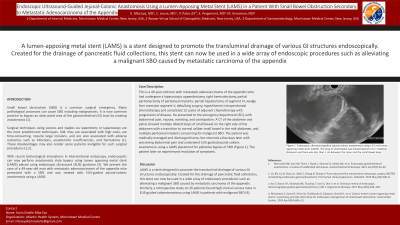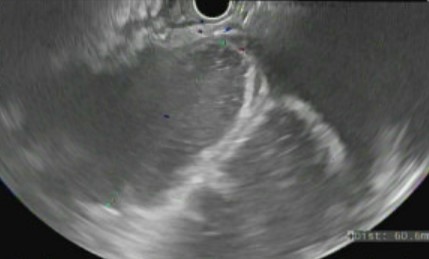Tuesday Poster Session
Category: Interventional Endoscopy
P4516 - Endoscopic Ultrasound-Guided Jejunal-Colonic Anastomosis Using a Lumen-Apposing Metal Stent (LAMS) in a Patient With Small Bowel Obstruction Secondary to Metastatic Adenocarcinoma of the Appendix
Tuesday, October 29, 2024
10:30 AM - 4:00 PM ET
Location: Exhibit Hall E

Has Audio

Karin Estelle Mba Eya, MD
American Gastroenterological Association
Morristown, NJ
Presenting Author(s)
Karin Estelle Mba Eya, MD1, Celia Leone, 2, Parth Jagrut Patel, 3, Matthew Grossman, MD4
1American Gastroenterological Association, Morristown, NJ; 2ACG, Morristown, NJ; 3Rowan-Virtua School of Osteopathic Medicine, Morristown, NJ; 4Morristown Medical Center, Morristown, NJ
Introduction: Small bowel obstruction (SBO) is a common surgical emergency. Many pathological processes can cause SBO including malignancies. It is now common practice to bypass an obstructed area of the gastrointestinal (GI) tract by creating anastomosis. Given the many disadvantages associated with surgical procedures some patients are ineligible for such procedures. With recent technological innovations in interventional endoscopy, it is possible to perform anastomotic style bypass using lumen apposing metal stents (LAMS) placed using endoscopic ultrasound (EUS) guidance. We present the case of a 49-year-old man with metastatic adenocarcinoma of the appendix who presented with a SBO and was treated with EUS-guided jejunal-colonic anastomosis using a LAMS.
Case Description/Methods: This is a 49-year-old man with metastatic adenocarcinoma of the appendix who had undergone laparoscopic appendectomy, right hemicolectomy, partial peritonectomy of peritoneal implants, partial hepatectomy of segment VI, wedge liver resection segment V, debulking surgery, hyperthermic intraperitoneal chemotherapy and completed 12 cycles of adjuvant chemotherapy with progression of disease. He presented to the emergency department (ED), with abdominal pain, nausea, vomiting, and constipation. A CT abdomen and pelvis showed multiple dilated loops of small bowel on the right side of the abdomen with a transition to normal caliber small bowel in the mid-abdomen, multiple peritoneal implants concerning for malignant SBO. The patient was medically managed and discharged home, but returned a few days later with worsening abdominal pain and underwent EUS-guided jejunal-colonic anastomosis using a LAMS placement for palliative bypass of SBO (Figure 1). The patient later on experienced resolution of symptoms.
Discussion: LAMS is a stent designed to promote the transluminal drainage of various GI structures endoscopically. Created for the drainage of pancreatic fluid collections, this stent can now be used in a wide array of endoscopic procedures such as alleviating a malignant SBO caused by metastatic carcinoma of the appendix. Similarly, a retrospective study conducted on 26 patients found high clinical success rates in EUS-guided coloenterostomy using LAMS in patients with malignant SBO(1).
1. Mitsuhashi S, Kamal F, Shinn BJ, Chalikonda D, Tyberg A, Shahid H, et al. Colonic-enteric lumen-apposing metal stents: a promising and safe alternative for endoscopic management of small-bowel obstruction. Gastrointest Endosc. 2024 Apr;99(4):606–13.

Disclosures:
Karin Estelle Mba Eya, MD1, Celia Leone, 2, Parth Jagrut Patel, 3, Matthew Grossman, MD4. P4516 - Endoscopic Ultrasound-Guided Jejunal-Colonic Anastomosis Using a Lumen-Apposing Metal Stent (LAMS) in a Patient With Small Bowel Obstruction Secondary to Metastatic Adenocarcinoma of the Appendix, ACG 2024 Annual Scientific Meeting Abstracts. Philadelphia, PA: American College of Gastroenterology.
1American Gastroenterological Association, Morristown, NJ; 2ACG, Morristown, NJ; 3Rowan-Virtua School of Osteopathic Medicine, Morristown, NJ; 4Morristown Medical Center, Morristown, NJ
Introduction: Small bowel obstruction (SBO) is a common surgical emergency. Many pathological processes can cause SBO including malignancies. It is now common practice to bypass an obstructed area of the gastrointestinal (GI) tract by creating anastomosis. Given the many disadvantages associated with surgical procedures some patients are ineligible for such procedures. With recent technological innovations in interventional endoscopy, it is possible to perform anastomotic style bypass using lumen apposing metal stents (LAMS) placed using endoscopic ultrasound (EUS) guidance. We present the case of a 49-year-old man with metastatic adenocarcinoma of the appendix who presented with a SBO and was treated with EUS-guided jejunal-colonic anastomosis using a LAMS.
Case Description/Methods: This is a 49-year-old man with metastatic adenocarcinoma of the appendix who had undergone laparoscopic appendectomy, right hemicolectomy, partial peritonectomy of peritoneal implants, partial hepatectomy of segment VI, wedge liver resection segment V, debulking surgery, hyperthermic intraperitoneal chemotherapy and completed 12 cycles of adjuvant chemotherapy with progression of disease. He presented to the emergency department (ED), with abdominal pain, nausea, vomiting, and constipation. A CT abdomen and pelvis showed multiple dilated loops of small bowel on the right side of the abdomen with a transition to normal caliber small bowel in the mid-abdomen, multiple peritoneal implants concerning for malignant SBO. The patient was medically managed and discharged home, but returned a few days later with worsening abdominal pain and underwent EUS-guided jejunal-colonic anastomosis using a LAMS placement for palliative bypass of SBO (Figure 1). The patient later on experienced resolution of symptoms.
Discussion: LAMS is a stent designed to promote the transluminal drainage of various GI structures endoscopically. Created for the drainage of pancreatic fluid collections, this stent can now be used in a wide array of endoscopic procedures such as alleviating a malignant SBO caused by metastatic carcinoma of the appendix. Similarly, a retrospective study conducted on 26 patients found high clinical success rates in EUS-guided coloenterostomy using LAMS in patients with malignant SBO(1).
1. Mitsuhashi S, Kamal F, Shinn BJ, Chalikonda D, Tyberg A, Shahid H, et al. Colonic-enteric lumen-apposing metal stents: a promising and safe alternative for endoscopic management of small-bowel obstruction. Gastrointest Endosc. 2024 Apr;99(4):606–13.

Figure: Figure 1. Endoscopic ultrasound guided jejunal-colonic anastomosis using a 15 mm lumen apposing metal stent (LAMS). The loop of small bowel was dilated about 6 cm in maximal diameter and there was less than 1 cm between the colon and the small bowel loop.
Disclosures:
Karin Estelle Mba Eya indicated no relevant financial relationships.
Celia Leone indicated no relevant financial relationships.
Parth Jagrut Patel indicated no relevant financial relationships.
Matthew Grossman indicated no relevant financial relationships.
Karin Estelle Mba Eya, MD1, Celia Leone, 2, Parth Jagrut Patel, 3, Matthew Grossman, MD4. P4516 - Endoscopic Ultrasound-Guided Jejunal-Colonic Anastomosis Using a Lumen-Apposing Metal Stent (LAMS) in a Patient With Small Bowel Obstruction Secondary to Metastatic Adenocarcinoma of the Appendix, ACG 2024 Annual Scientific Meeting Abstracts. Philadelphia, PA: American College of Gastroenterology.
